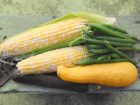By Clare Ellis
How did one small goat farm in Pescadero, California manage to collect almost 12,000 “likes” on its Facebook page? “It just kind of happened,” says Adriana Serrano, who works Harley Farms alongside owner Dee Harley. She claims the 20-year-old farm doesn’t do anything special to generate all those fans. “We never invite anyone to follow us, or anything like that,” she says.
Her response turned out to be typical of the comments we heard from other farmers. None had the stadium-sized support base enjoyed by Harley Farms, but most have “likes” numbering in the low thousands, which is more than respectable for a small farm. And how did they get there? Growth has been “largely organic,” “we’re doing nothing special,” and “it’s just humming along on its own.”
Really?
Local farms undoubtedly benefit from our growing love affair with local food but “likes” don’t multiply on their own. In fact, if you look more closely at Harley Farms a lot of work went into generating that kind of popularity. For one thing, Harley Farms illustrates the value of getting out from behind the tractor – or desk or computer – and talking to customers. It offers four tours every weekend throughout the year – that’s 80 people coming through the barn each week to commune with the goats, watch cheese being made, and forge a connection. It hosts dinners, parties, and has a deliciously old-fashioned store where you can sample goat cheese, olive oil, and honey (pictured above). It also has a blog, a newsletter, and a website, which keep their public tied in and serve as a platform for the Facebook page, which the Farm launched three years ago.
While Dee and company apparently don’t dream up Facebook strategies, she has decided to give the people who visit the farm and taste its products a good experience, which of course is the source of organic growth. Still, in order for any kind of growth to develop there have to be at least a few basics in place. At the least that means making it easy to find your page, keeping the page up to date, and generating good content. (More on what makes “good content” later.)
In an upcoming story we’ll fill you in on how to more aggressively promote your page, something that Jeff Bordes, of Frog Hollow Farm in Brentwood, California, says is on his agenda. “We’ve never done a “Like us on facebook and get 10% off” deal,” he says, “though we hope to offer more unique incentives for our FB following in the future.”
In the meantime, let’s start with the basics.
- Make yourself easy to find. First get a user name, which allows you to send people directly to your page. You can grab one after you’ve landed 25 fans (visit set up username for help). Once you’ve got your user name, list it wherever you can – on your website, your Facebook personal page, your linked in profile, your email signature, your business card, your Twitter bio. In short, anywhere you’re likely to make a connection.
- Be nice. Don’t just tell people to come like your page. Invite them to “join our community!” or “follow us for great recipes and savings!” Make them believe they’ll get something by “liking” your page.
- Make daily posting a habit. Fresh content is good content. Many experts recommend posting two or three times throughout the day though a few suggest as many as six. It all depends on your business. If you’re juggling marketing tasks with, say, milking goats, then once a day might be enough. Just as important as freshening your content is not overdoing it – the quickest way to getting “unliked.”
- Time your posts. If your posts are infrequent try to time them to arrive when most fans are likely to see it. You can try to keep track of when you tend to get a lot of comments or “likes.” A more precise way of monitoring activity is to use Crowdbooster, which lets you see when people are visiting your page. Another helpful tool is Buffer, which lets you enter your content ahead of time in Facebook and Twitter and then schedule its release so you don’t have to stick around all day on the computer.
- Engage with your visitors. Talk to your people. Make them feel welcome. Some of the most popular food and farm pages we reviewed do nothing fancy whatsoever. They succeed by treating every poster as a friend and sometimes that’s enough. The goal is to generate discussions and interactions. The more activity, the higher Facebook ranks your page and the more likely you’ll rise to the top of your fans’ newsfeed. Also, you’ll get points off if there’s a big difference between the number of likes on your page and the number of people “talking about” your page. So seize every comment as an opportunity to connect with your followers. (This sounds lame but “liking” yourself after you post something counts as engagement, so why not.)
- Ask your friends for help…or maybe not. Your friends already do so much for you. Plus, the “invite friends” feature on Facebook is notoriously buggy at the moment. This advice also works better if you have young friends who spend more time on Facebook and are freer with their “likes”. That said, when there’s that one lonely “like” just hanging there on the page, asking a few friends personally to help get the ball rolling can’t hurt. Like they say, what are friends for?
- Create good content. So what qualifies as “good”? Look for nuggets of information that reveal what’s special about your business, be it how many goats are pregnant or the winning recipe in a cook-off using the company’s organic tomato sauce. If it’s hard to generate something new and interesting every day, get to know some other great content sources in your field and share their content. Insights, the analytics tab on your FB page, gives you a clear view into which of your posts generate the most activity. Here’s what it won’t tell you: Facebook values pictures most highly, followed by videos, links, updates, and apps.
The question of what makes good content is one Good Food Media Group will return to many times. For one angle, consider my visit to Harley Farms. I met the goats and inadvertently fed them a few notes, sampled goat cheeses and honey, hung out with a free range pig and a mule. There was no “join us on Facebook!” sign at the register on my way out but the good feelings stirred up by my visit persisted until I got home an hour later and, yes, “liked” the Farm’s Facebook page. Now that is great marketing.
-Clare Ellis, Media Chief, Good Food Media Group
Similar Stories:
- 5 ways to keep on top of social media demands
- To Blog or Not to Blog?
- Five Myths About Food Safety and Home Gardens
- Innovative Ways to Raise Cash
- Fast Food Meets Humane Farming




